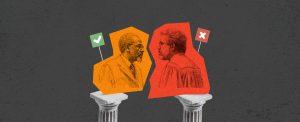It seems hard to believe that, over the past several years, the concepts of kindness and compassion have emerged as trends in discussions around regulation – a field which many might describe as dispassionate and legalistic by nature.
But case studies from regulators like the Australian Health Practitioner Regulation Agency (Ahpra), interviews with Ascend Radio guests like Association for Dental Education in Europe (ADEE) CAO Denis Murphy and the University of Toronto’s Zubin Austin, and expert panels from the Council on Licensure, Enforcement and Regulation (CLEAR) seem to demonstrate that calls for kindness in regulation have, to some extent, picked up steam. Even as recently as January 2024, CLEAR’s Winter Symposium featured the theme “Coding Kindness: Regulatory Approaches to Technology and Compassion.”
So why are people talking about it? What place does kindness have in regulation? There are, of course, the principles of kindness we may expect licensees to practice when dealing with the public, particularly in the context of health care, but many have also begun to ask whether we treat regulated professionals with enough kindness to ensure effective outcomes.
But even then, how do we define arguably subjective concepts like kindness and compassion in this context? Well, one thing that seems to be common across many differing perspectives on the issue is an acknowledgement that these terms do not always capture what the underlying principles of kindness and compassion look like in practice.
Ascend Radio guests weigh in
In his Ascend Radio appearance, for example, Denis Murphy said the introduction of compassion as a regulatory concept alters the dynamic between the regulator and the regulated professional. From his perspective, a registrant only appears in front of a regulator once they have done something wrong, and because the regulator’s job is to investigate the situation and make whatever decision best protects the public, a focus on “compassion” toward the registrant could get in the way of this public protection.
What Murphy does acknowledge about compassion in regulation is that its underlying concepts – things like regulatory efficiency, clear communication, and transparency in decision-making – have been around for quite some time. These ideals existed, for example, as part of the principles in Right-touch regulation, Murphy argues, and to some extent, they have simply been repackaged under new language that can be confusing and unclear.
Zubin Austin, another Ascend Radio guest, expressed a similar sentiment in his appearance on the podcast, saying he is “fundamentally dissatisfied” with the term kindness as it is applied to regulation. Civility, politeness, and common decency, Austin says, are all terms that come closer to describing what kindness looks like in regulatory practice.
As an example, Austin suggested a hypothetical case in which a licensee is told impersonally, via email, that an issue has been raised against them and that failure to comply with the regulator’s orders by a certain date will result in legal action. This rather antagonistic approach could prompt the registrant to call for legal backup and escalate the situation, leading to a waste of time and resources as the dispute plays out.
Instead, Austin says an approach more in line with the spirit of “kindness and compassion” would ideally focus on conversations and understanding, rather than on ascribing blame. He argues that such an approach has been demonstrated in other parts of society to be more effective, less costly, and more humanistic.
Kindness in practice
This conversation isn’t only happening on podcasts and expert panels, either. One need only look at the Australian Health Practitioner Regulation Agency (Ahpra) for an example of how a kinder, more human approach to regulation can work in practice. A 2022 article from Ahpra’s Susan Biggar, published in the International Journal for Quality in Health Care, proposes three actions to embed kindness in regulatory processes:
- Developing a more nuanced approach to regulation, using better risk assessment to triage complaints.
- Identifying and addressing the various “pain points” in the regulatory process.
- Collaborating within the broader patient safety system and tackling the narrative of blame.
The article also offers a breakdown of how Ahpra approached the issue, saying the agency “analyzed feedback from over 8,000 practitioners and complainants to initiate steps towards a more humane and kinder approach to regulation.”
According to Biggar, Ahpra has prioritized communication skills in its hiring and development process and begun encouraging more personal contact with practitioners and complainants. Like the approach outlined by Austin in his Ascend Radio appearance, the agency also changed legalistic language in its dispute resolution process to “reduce the stress and shame experienced by practitioners while recognizing the hurt or loss commonly experienced by complainants.”
Perhaps the discussion around kindness in regulation is best understood as a response to the bureaucratic, impersonal, and sometimes antagonistic nature of complaints and discipline. Perhaps it is about, as Austin puts it, giving everybody an opportunity to talk, to understand, to share, and to get to the core of a dispute – rather than making a binary, winner-takes-all decision – in order to achieve a more cost-effective and favorable outcome for everyone involved.
MORE VOICES ARTICLES

Trust on trial: Navigating the murky waters of scientific integrity
As fraudulent research papers flood academic journals, the sanctity of scientific discovery is under siege, challenging the very foundation of trust we place in peer-reviewed publications. With AI now both a tool for creating and detecting such deceptions, the urgency for a robust, independent regulatory framework in scientific publishing has never been greater.

Do regulators deserve deference?
In a pivotal moment for regulatory law, the U.S. Supreme Court’s review of the Chevron doctrine could redefine the bounds of deference courts give to regulatory agencies, potentially inviting more challenges to their authority. This critical examination strikes at the heart of longstanding legal principles, signaling a significant shift in the landscape of regulatory oversight and its interpretation by the judiciary.

From Frankenstein to Siri: Accountability in the era of automation
As AI advances in sectors from health care to engineering, who will be held accountable if it causes harm? And as human decision-makers are replaced by algorithms in more situations, what will happen to uniquely human variables like empathy and compassion? Harry Cayton explores these questions in his latest article.

Regulating joy: The risky business of festivities
In his final Voices article of 2023, Harry Cayton reflects on our enthusiasm for participating in cultural festivities that often cause injuries or even deaths, which has led some governments to attempt to regulate these risky celebrations.

Building my regulator of tomorrow with LEGO® bricks
What should the regulator of tomorrow look like? While there may be no definitive vision, contributor Rick Borges gets creative with answering this important question, drawing inspiration from a favorite toy to ‘build’ a model of an effective future regulator.

‘Thin’ and ‘thick’ rules of regulation: Cayton reviews Daston’s history of what we live by
Lorraine Daston explores fascinating examples of rulemaking throughout history in her new book, ‘Rules: A Short History of What We Live By.’ In this article, Harry Cayton discusses what regulators can learn from Daston’s work.








